Sheer chance was forging a chain of irrevocable circumstance that afternoon early in 1931 when I stopped at the editorial offices of Street & Smith, the one place where I had no good reason to be that day or for some time to come.
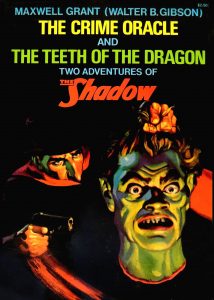 So writes Walter B. Gibson in “My Years with The Shadow,” his introduction to THE CRIME ORACLE AND THE TEETH OF THE DRAGON: TWO ADVENTURES OF THE SHADOW, published by Dover Books in 1975.
So writes Walter B. Gibson in “My Years with The Shadow,” his introduction to THE CRIME ORACLE AND THE TEETH OF THE DRAGON: TWO ADVENTURES OF THE SHADOW, published by Dover Books in 1975.
The Shadow had been introduced to the public on July 31, 1930. The character was the mysterious narrator for THE DETECTIVE STORY HOUR, a CBS radio program sponsored by the Street & Smith pulp chain.
With customers inquiring for “that Shadow magazine” at newsstands, the publisher thought the time might be ripe for a revival of the single-character magazine.
In 1931, Walter Gibson had been a full-time professional writer for over ten years, supplying daily features to Philadelphia’s Ledger Syndicate and other newspaper syndicates. He had written the book HOUDINI’S ESCAPES for Harcourt, Brace, and Company, and was a regular contributor of “fictionized fact articles” for Macfadden’s TRUE STRANGE STORIES. He was also a ghostwriter for magicians Harry Blackstone, Harry Houdini, and Howard Thurston, penning articles and books for them under their names.
On the day that he visited Street & Smith, Gibson had just landed a pair of book contracts. One was to be a sequel to his Houdini book, while the other was BLACKSTONE’S MODERN CARD TRICKS. Again Gibson:
Those two contracts for new books were like stepping stones to my big ambition, which was to crack the mystery field with a hard-cover, full-fledged novel. For that, I needed an outstanding character and I had been thinking of one who would be a mystery in himself, moving into the affairs of lesser folk much to their amazement. By combining Houdini’s penchant for escapes with the hypnotic power of Tibetan mystics, plus the knowledge shared by Thurston and Blackstone in the creation of illusions, such a character would have unlimited scope when confronted by surprise situations, yet all could be brought within the range of credibility.
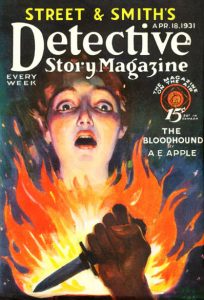 Whether or not this was all happenstance or a “fictionized fact article,” he stopped by Street & Smith to discuss “a series of shorts on factual crimes” that had interested Frank Blackwell, Street & Smith editor-in-chief.
Whether or not this was all happenstance or a “fictionized fact article,” he stopped by Street & Smith to discuss “a series of shorts on factual crimes” that had interested Frank Blackwell, Street & Smith editor-in-chief.
. . . when I mentioned the proposed factual articles, Blackwell dismissed the subject completely. He had something quite different to discuss and came right to the point. Street & Smith were testing new magazines to meet increasing competition and they had decided to revive the “character” field. It would be a flashback to the days of Frank Merriwell and the original Nick Carter, or even Buffalo Bill, but with a modern slant. Specifically, they wanted a character to be called “The Shadow,” as a tie-in with an announcer’s voice that was being used to introduce THE DETECTIVE STORY HOUR, a weekly radio program that dramatized a short story from each new issue of DETECTIVE STORY MAGAZINE.
. . . that intrigued me, for it fitted with the very type of character that I already had in mind. When Blackwell asked if I had any ideas, I went right into a verbal description . . . It was . . . enough for Blackwell. He told me to use my character as The Shadow and pick it up from there, putting The Shadow and his agents on the track of a mystery involving murder and robbery with whatever cross-purpose or false trails I needed. I was to come back with a few opening chapters and a general outline within a week.
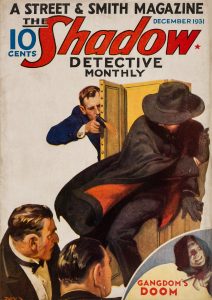 True story or sleight-of-hand, Gibson got the job. But after the first two issues of THE SHADOW: A DETECTIVE MAGAZINE had flown off the stands, Gibson signed on to produce one story a month. About a year later, he was asked to double his output as THE SHADOW MAGAZINE was to appear twice each month.
True story or sleight-of-hand, Gibson got the job. But after the first two issues of THE SHADOW: A DETECTIVE MAGAZINE had flown off the stands, Gibson signed on to produce one story a month. About a year later, he was asked to double his output as THE SHADOW MAGAZINE was to appear twice each month.
Writing as Maxwell Grant, Gibson single-handedly produced the first 112 Shadow novels. Then to Gibson’s surprise, “Partners of Peril,” was published in the November 1, 1936 number of THE SHADOW MAGAZINE. It introduced a new writer to Walter Gibson and Shadow readers — Theodore A. Tinsley.
According to a letter written by Ted Tinsley in 1978:
I appeared on the scene because of the feeling at S&S that if Walt Gibson in a fit of absentmindedness walked in front of a speeding taxicab, it would be handy to have another good-looking, clean-cut “Maxwell Grant” ready to present a masterpiece tailored to the image and likeness of the Founding Father. In this I am — and will — say that I did a damned good job in all.
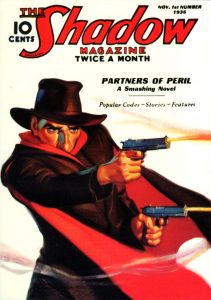 From 1936 – 1943, Theodore Tinsley wrote 27 of The Shadow’s adventures. Although modeled after Gibson’s formula, Tinsley’s Shadow tales are more hardboiled, violent, and sexual. This, despite pulp writer Frank Gruber’s description of the author:
From 1936 – 1943, Theodore Tinsley wrote 27 of The Shadow’s adventures. Although modeled after Gibson’s formula, Tinsley’s Shadow tales are more hardboiled, violent, and sexual. This, despite pulp writer Frank Gruber’s description of the author:
Theodore Tinsley was a mild-mannered man of about forty who lived in the Bronx and was that rare article, a native New Yorker. . . . He was an extremely conservative man, a plodding hard-working writer, not given the frivolous things. (He) worked for years in the office of a large insurance company.
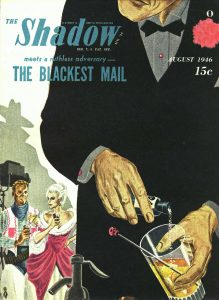 In 1946, Walter Gibson left THE SHADOW due to a contract dispute. His replacement was Bruce Elliott — a writer and editor for magic journals who had been introduced to Street & Smith by Gibson.
In 1946, Walter Gibson left THE SHADOW due to a contract dispute. His replacement was Bruce Elliott — a writer and editor for magic journals who had been introduced to Street & Smith by Gibson.
The third Maxwell Grant had begun working on the publisher’s comic books in 1940. According to the late Robert Sampson, editor William de Grouchy liked Elliott’s work and had asked him to write some Nick Carter backup stories for THE SHADOW. “When the contract dispute with Gibson occurred, de Grouchy again turned to Elliott, this time for Shadow novels.”
Whereas Theodore Tinsley had modeled his Shadow novels after Gibson’s format, the Elliott Shadow was largely subsumed by Lamont Cranston. Again Sampson:
In Elliott, Cranston is Cranston. No concealed identity here. No gaunt aviator’s face masked by putty. Cranston is Cranston. . . . His profession — if you must call it that — is that of criminology, in this case, a fancy word that means amateur detective. It is Cranston’s fancy to solve crimes.
On Saturday, August 21, join PulpFest 2021 as we welcome Ed Hulse, Will Murray, Jim Steranko, and Anthony Tollin for “Walter B. Gibson and His Shadows,” a look at the men who were Maxwell Grant related by those who knew them. Our presentation will take place at the DoubleTree by Hilton Hotel Pittsburgh – Cranberry, beginning at 7:55 PM.
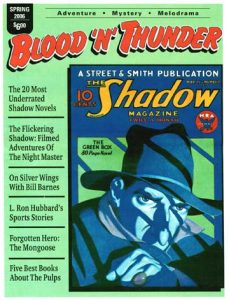 Our moderator, Ed Hulse, is a journalist and pop culture historian who covered the home video and motion picture industries for more than 30 years. His work has appeared in ENTERTAINMENT WEEKLY, THE NEW YORKER, THE NEW YORK TIMES, PLAYBOY, PREMIER, VARIETY, and numerous trade publications. During the late 1980s, his articles and movie reviews were syndicated to newspapers by the Washington Post Writers Group.
Our moderator, Ed Hulse, is a journalist and pop culture historian who covered the home video and motion picture industries for more than 30 years. His work has appeared in ENTERTAINMENT WEEKLY, THE NEW YORKER, THE NEW YORK TIMES, PLAYBOY, PREMIER, VARIETY, and numerous trade publications. During the late 1980s, his articles and movie reviews were syndicated to newspapers by the Washington Post Writers Group.
Since 2002, Hulse has edited and published the award-winning journal BLOOD ‘N’ THUNDER, which covers pulp and pop-culture history. Ed is a prolific public speaker who has lectured on various aspects of vintage American popular culture for museums, libraries, and universities. His books include THE BLOOD ‘N’ THUNDER GUIDE TO PULP FICTION, FILMING THE WEST OF ZANE GREY, DISTRESSED DAMSELS, AND MASKED MARAUDERS, and most recently WAGE SLAVES IN THE DREAM FACTORY. In 2017, he co-edited THE ART OF THE PULPS, with Doug Ellis and the late Robert Weinberg. Forthcoming is his illustrated history of vintage paperbacks, THE ART OF PULP FICTION. Ed’s website can be found at muraniapress.com.
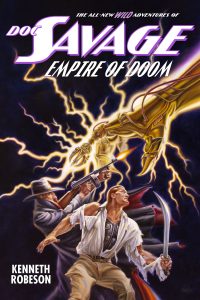 Will Murray has written extensively about Lester Dent’s Doc Savage, as well as countless other pulp and pop culture topics. He first discovered pulp fiction as a teenager, when he spotted a Doc Savage paperback on a spinner rack. He began collecting pulp originals soon thereafter and started writing for fanzines, specifically about Doc Savage. From 1975 – 77, he edited and largely wrote the pulp fanzine, DUENDE. A few years later, he wrote THE DUENDE HISTORY OF THE SHADOW MAGAZINE, an excellent history of the character and pulp magazine. Murray’s other non-fiction books include WRITINGS IN BRONZE and WORDSLINGERS: AN EPITAPH FOR THE WESTERN.
Will Murray has written extensively about Lester Dent’s Doc Savage, as well as countless other pulp and pop culture topics. He first discovered pulp fiction as a teenager, when he spotted a Doc Savage paperback on a spinner rack. He began collecting pulp originals soon thereafter and started writing for fanzines, specifically about Doc Savage. From 1975 – 77, he edited and largely wrote the pulp fanzine, DUENDE. A few years later, he wrote THE DUENDE HISTORY OF THE SHADOW MAGAZINE, an excellent history of the character and pulp magazine. Murray’s other non-fiction books include WRITINGS IN BRONZE and WORDSLINGERS: AN EPITAPH FOR THE WESTERN.
The literary agent for the Lester Dent properties, he became an unofficial adviser to Bantam Books’ Doc Savage reprint program and adapted two Doc Savage novels for National Public Radio’s THE ADVENTURES OF DOC SAVAGE. After ghost-writing forty entries in the best-selling DESTROYER action-adventures series, he began penning new adventures of Doc Savage. To date, Murray has penned over twenty Docs — most based on Lester Dent manuscripts. Two of his Doc Savage novels have also featured The Shadow.
Other Will Murray creations include new adventures of King Kong, The Spider, and Tarzan, as well as a substantial number of Sherlock Holmes stories. With Anthony Tollin, he co-edited and contributed to Sanctum Books’ very successful series of pulp reprints. He was recently profiled by PulpFest on our website. You can find Will’s website at adventuresinbronze.com.
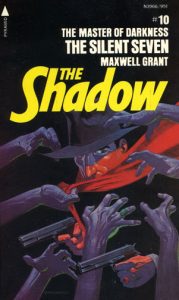 Jim Steranko is an American graphic artist, comic book artist and writer, popular culture historian, magician, publisher, and film production illustrator. His most famous comic book work was with Marvel’s NICK FURY: AGENT OF SHIELD, published in 1967 – 68. An extremely innovative artist, he added surrealism, pop art, and graphic design into the medium. In 1976, he produced CHANDLER: RED TIDE, an early version of the graphic novel.
Jim Steranko is an American graphic artist, comic book artist and writer, popular culture historian, magician, publisher, and film production illustrator. His most famous comic book work was with Marvel’s NICK FURY: AGENT OF SHIELD, published in 1967 – 68. An extremely innovative artist, he added surrealism, pop art, and graphic design into the medium. In 1976, he produced CHANDLER: RED TIDE, an early version of the graphic novel.
Steranko’s work has been published in many countries and his influence on the field has remained strong to this day. He has written a pioneering two-volume history of the birth and early years of comic books and created conceptual art and character designs for films including RAIDERS OF THE LOST ARK and BRAM STOKER’S DRACULA. Jim has also designed and painted many book covers, most notably the Pyramid/Jove SHADOW series published in the 1970s.
Anthony Tollin is a noted expert on comics, pulps, and old-time radio. He was a prominent colorist and production artist for DC Comics, contributing to such titles as CRISIS ON INFINITE EARTHS, GREEN LANTERN, INFINITY, INC., and two comic book incarnations of THE SHADOW.
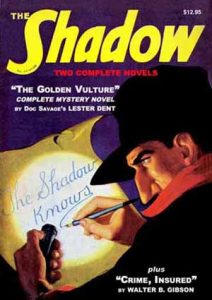 In 2006, Tollin launched the Sanctum Books series of double novel pulp reprints. To date, he has reprinted all 182 DOC SAVAGE pulp novels, the fourteen WHISPERER novels from the original pulp series, the entire run of Paul Ernst’s AVENGER novels, and all but three of the original SHADOW novels — all in non-flaking editions with the classic color covers and original interior illustrations, plus comprehensive historical articles and features. Some of these features have included rare radio scripts as well as reprints of Street & Smith comic book stories such as the Iron Munro yarns of Theodore Sturgeon. Additionally, Sanctum Books has reprinted selected adventures featuring THE BLACK BAT, NICK CARTER, THE PHANTOM DETECTIVE, THE SKIPPER, and THE SPIDER in the double novel format.
In 2006, Tollin launched the Sanctum Books series of double novel pulp reprints. To date, he has reprinted all 182 DOC SAVAGE pulp novels, the fourteen WHISPERER novels from the original pulp series, the entire run of Paul Ernst’s AVENGER novels, and all but three of the original SHADOW novels — all in non-flaking editions with the classic color covers and original interior illustrations, plus comprehensive historical articles and features. Some of these features have included rare radio scripts as well as reprints of Street & Smith comic book stories such as the Iron Munro yarns of Theodore Sturgeon. Additionally, Sanctum Books has reprinted selected adventures featuring THE BLACK BAT, NICK CARTER, THE PHANTOM DETECTIVE, THE SKIPPER, and THE SPIDER in the double novel format.
Anthony worked with Walter B. Gibson on THE SHADOW SCRAPBOOK, published in 1979 by Harcourt Brace Jovanovich, Inc., and wrote THE SHADOW: THE MAKING OF A LEGEND, a lavishly illustrated history of THE SHADOW on radio. He also narrated an audio documentary that includes program excerpts and interviews with Orson Welles, Bill Johnstone, John Archer, Bret Morrison, Walter B. Gibson, pulp editor John Nanovic, and the last surviving broadcast featuring an interview with Gertrude Warner.
The general public is welcome to attend our evening programming events. To learn more about our programming schedule, please click the Programming button at the top of this page.
For those who also want to enjoy our dealers’ room, you can join PulpFest by clicking the Registration button at the top of this page. And don’t forget to book a room at the DoubleTree. They’re going fast!
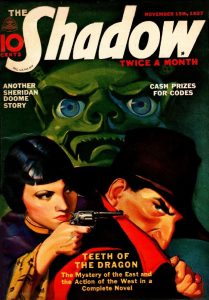 THE CRIME ORACLE AND THE TEETH OF THE DRAGON: TWO ADVENTURES OF THE SHADOW was published by Dover Books in 1975. The cover art by George Rozen was originally created for the June 1, 1936 issue of THE SHADOW MAGAZINE, featuring “The Crime Oracle” and other stories. The companion novel in the Dover edition — “The Teeth of the Dragon” — originally ran in the November 15, 1937 issue, also featuring cover art by George Rozen.
THE CRIME ORACLE AND THE TEETH OF THE DRAGON: TWO ADVENTURES OF THE SHADOW was published by Dover Books in 1975. The cover art by George Rozen was originally created for the June 1, 1936 issue of THE SHADOW MAGAZINE, featuring “The Crime Oracle” and other stories. The companion novel in the Dover edition — “The Teeth of the Dragon” — originally ran in the November 15, 1937 issue, also featuring cover art by George Rozen.
John Coughlin contributed the front cover art for the April 18, 1931 number of Street & Smith’s DETECTIVE STORY MAGAZINE. This issue followed the end of the “$1000 Shadow Contest,” described in our post, “Selling the Shadow.” John G. Porter of Chicago, Illinois was the winner of the contest.
The first two issues of THE SHADOW: A DETECTIVE MAGAZINE used recycled covers from older Street & Smith magazines. Beginning with the third issue, Jerome Rozen took on the cover chores. Rozen would contribute the cover art for the third, fourth, sixth, and seven issues. Afterward, his brother George would become the lead cover artist for the magazine. George Rozen would contribute nearly 200 cover paintings to the magazine. Pictured here is the fifth issue, dated December 1931. It is the third monthly issue of the magazine.
The November 1, 1936 number of THE SHADOW MAGAZINE — featuring cover art by George Rozen — features the first of 27 Shadow novels written by Theodore A. Tinsley, “Partners of Peril.”
Bruce Elliott’s first Shadow adventure, “The Blackest Mail,” appeared in the August 1946 issue of THE SHADOW. The cover artist is not known. All told, Elliott would write fifteen of The Dark Avenger’s tales.
The fourteenth issue of Ed Hulse’s BLOOD ‘N’ THUNDER features a couple of articles on The Shadow. Dated Spring 2006, it sports George Rozen’s cover art for “The Green Box,” originally published in the March 15, 1934 number of THE SHADOW MAGAZINE.
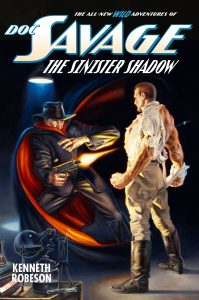 Will Murray’s (writing as Kenneth Robeson) EMPIRE OF DOOM is the second of two Doc Savage novels to feature The Shadow. It was published in 2017, with jacket art by Joe DeVito. The other Shadow/Doc Savage crossover is THE SINISTER SHADOW, published in 2015. It also featured DeVito jacket art.
Will Murray’s (writing as Kenneth Robeson) EMPIRE OF DOOM is the second of two Doc Savage novels to feature The Shadow. It was published in 2017, with jacket art by Joe DeVito. The other Shadow/Doc Savage crossover is THE SINISTER SHADOW, published in 2015. It also featured DeVito jacket art.
Jim Steranko painted the cover art for Walter B. Gibson’s (writing as Maxwell Grant) THE SILENT SEVEN. Published in 1975 by Pyramid Books, it reprinted the lead novel that originally appeared in the seventh issue of THE SHADOW DETECTIVE MONTHLY, dated February 1932.
Incidentally, there was actually a fourth Maxwell Grant. In 1932, Lester Dent was asked to write a Shadow novel as a tryout to the Doc Savage contract. His story, “The Golden Vulture,” was eventually revised by Walter Gibson and published in the July 15, 1938 issue of THE SHADOW, featuring cover art by George Rozen. The artist’s cover would later be used to illustrate the first volume of Sanctum Books’ Double Shadow Novels, reprinting the Dent/Gibson story and Walter B. Gibson’s “Crime, Insured.”







